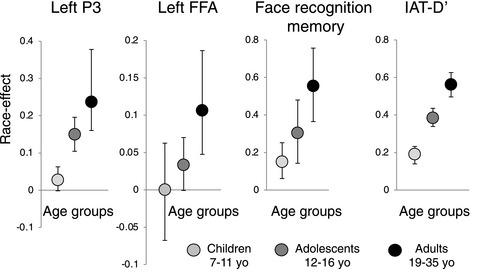Our official English website, www.x-mol.net, welcomes your feedback! (Note: you will need to create a separate account there.)
The development of race effects in face processing from childhood through adulthood: Neural and behavioral evidence
Developmental Science ( IF 4.939 ) Pub Date : 2020-11-05 , DOI: 10.1111/desc.13058 Golijeh Golarai 1 , Dara G. Ghahremani 1, 2 , Anders C. Greenwood 3 , John D. E. Gabrieli 1, 4 , Jennifer L. Eberhardt 1
Developmental Science ( IF 4.939 ) Pub Date : 2020-11-05 , DOI: 10.1111/desc.13058 Golijeh Golarai 1 , Dara G. Ghahremani 1, 2 , Anders C. Greenwood 3 , John D. E. Gabrieli 1, 4 , Jennifer L. Eberhardt 1
Affiliation

|
Most adults are better at recognizing recently encountered faces of their own race, relative to faces of other races. In adults, this race effect in face recognition is associated with differential neural representations of own‐ and other‐race faces in the fusiform face area (FFA), a high‐level visual region involved in face recognition. Previous research has linked these differential face representations in adults to viewers’ implicit racial associations. However, despite the fact that the FFA undergoes a gradual development which continues well into adulthood, little is known about the developmental time‐course of the race effect in FFA responses. Also unclear is how this race effect might relate to the development of face recognition or implicit associations with own‐ or other‐races during childhood and adolescence. To examine the developmental trajectory of these race effects, in a cross‐sectional study of European American (EA) children (ages 7–11), adolescents (ages 12–16) and adults (ages 18–35), we evaluated responses to adult African American (AA) and EA face stimuli, using functional magnetic resonance imaging and separate behavioral measures outside the scanner. We found that FFA responses to AA and EA faces differentiated during development from childhood into adulthood; meanwhile, the magnitudes of race effects increased in behavioral measures of face‐recognition and implicit racial associations. These three race effects were positively correlated, even after controlling for age. These findings suggest that social and perceptual experiences shape a protracted development of the race effect in face processing that continues well into adulthood.
中文翻译:

从童年到成年的面部加工中种族效应的发展:神经和行为证据
与其他种族的面孔相比,大多数成年人更擅长识别自己种族中最近遇到的面孔。在成年人中,人脸识别中的种族效应与梭形人脸区域(FFA)中涉及自己和其他种族的脸部的差异神经表示相关,FFA是人脸识别中涉及的高级视觉区域。先前的研究已将成年人中这些差异化的面部表情与观看者的隐性种族联想联系起来。然而,尽管事实上FFA经历了逐渐发展并持续到成年的事实,但对FFA反应中种族效应的发展时程知之甚少。同样不清楚的是,这种种族效应可能与儿童和青少年时期的面部识别或与自身或其他种族的隐式关联发展有关。为了检验这些种族效应的发展轨迹,在一项针对美国儿童(7-11岁),青少年(12-16岁)和成人(18-35岁)的横断面研究中,我们评估了成人非洲人(AA)和EA脸部刺激,使用功能性磁共振成像并在扫描仪外部进行单独的行为测量。我们发现,FFA对AA和EA面孔的反应在从童年到成年的发育过程中有所不同。同时,人脸识别和内隐种族联想的行为量度中种族效应的幅度也增加了。即使控制了年龄,这三个种族效应也呈正相关。这些发现表明,社交和感性经历会在面部加工过程中长期影响种族效应,并持续到成年。
更新日期:2020-11-05
中文翻译:

从童年到成年的面部加工中种族效应的发展:神经和行为证据
与其他种族的面孔相比,大多数成年人更擅长识别自己种族中最近遇到的面孔。在成年人中,人脸识别中的种族效应与梭形人脸区域(FFA)中涉及自己和其他种族的脸部的差异神经表示相关,FFA是人脸识别中涉及的高级视觉区域。先前的研究已将成年人中这些差异化的面部表情与观看者的隐性种族联想联系起来。然而,尽管事实上FFA经历了逐渐发展并持续到成年的事实,但对FFA反应中种族效应的发展时程知之甚少。同样不清楚的是,这种种族效应可能与儿童和青少年时期的面部识别或与自身或其他种族的隐式关联发展有关。为了检验这些种族效应的发展轨迹,在一项针对美国儿童(7-11岁),青少年(12-16岁)和成人(18-35岁)的横断面研究中,我们评估了成人非洲人(AA)和EA脸部刺激,使用功能性磁共振成像并在扫描仪外部进行单独的行为测量。我们发现,FFA对AA和EA面孔的反应在从童年到成年的发育过程中有所不同。同时,人脸识别和内隐种族联想的行为量度中种族效应的幅度也增加了。即使控制了年龄,这三个种族效应也呈正相关。这些发现表明,社交和感性经历会在面部加工过程中长期影响种族效应,并持续到成年。



























 京公网安备 11010802027423号
京公网安备 11010802027423号